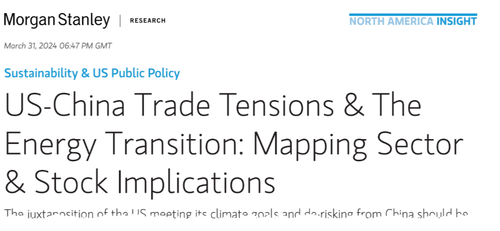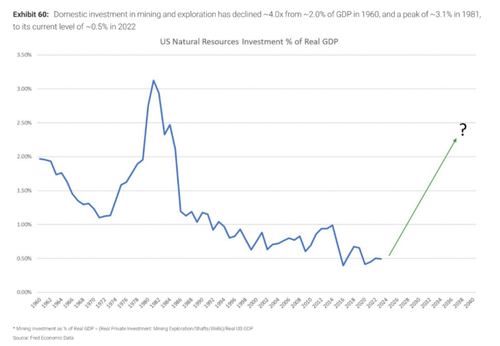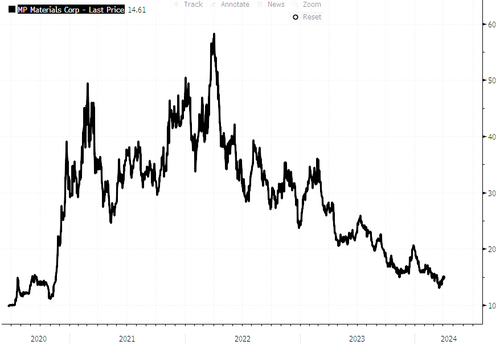
Abandoning petrol-burning vehicles and adopting low-carbon technologies to power tomorrow's economy are trends accelerating across the nation. To do this, access to rare earth metals, key ingredients in many of these 'green' technologies, must be sourced domestically - not from China, an emerging national security threat to the US. As the world fractures into a multipolar state, there is a big push domestically to revive America's metals and mining industry and reduce reliance on Asia.
Morgan Stanley analyst Carlos De Alba recently conveyed his optimistic outlook for the US metals and mining sector to clients. He highlighted that investment levels in the industry have reached their lowest level in decades. He believes the sector is poised for massive investments and outlines the companies that will benefit.
"US reliance on import critical minerals has reached a 30-year high, and investment in the industry is near its lowest point in decades," the analyst said, pointing out America's heavy reliance on imported minerals from China:
"The US government has identified 50 minerals it deems critical to the US economy and to national security; for 43 of those critical minerals, more than 50% of domestic consumption depends on imports.
Since 1990, the US has seen a significant increase in both the variety of imported minerals and the level of dependence on these imports. In 1990, the US was fully reliant on imports for the supply of 9 minerals, and imports exceeded 50% of consumption for 27 minerals (including all minerals, not only critical ones).
These figures have risen to 15 and 51, respectively, as of 2022. China currently dominates the global mineral processing/refining industry, and the US is heavily reliant on China (>50% of net import reliance) for imports of 26 minerals."
China's global dominance in rare earth metals is a national security threat. Were Western leaders asleep at the wheel over the last three-plus decades to allow this to happen?
The analyst detailed how China dominates the global supply of rare earth minerals and cautioned against rising vulnerabilities in US mineral supply chains, especially given the ongoing tensions in Sino-US relations:
"China is in a powerful position to influence the global mineral markets and has already started to flex its strength through mineral export restrictions. For US policymakers, the US's mineral dependence on imports highlights the growing vulnerability of the US mineral supply chain and the urgent need to strengthen domestic supply chains. In addition, the US faces a multi-decade decline in investment in the domestic mining and exploration industry, which has fallen from ~2.0% of GDP in 1960 (and a peak of ~3.1% in 1981) to just ~0.5% today."
After being asleep at the wheel for decades, the bloated US government, thank former President Trump - has awakened from its slumber and realized that it must play a serious "catch-up" game with policy reform and incentives for private industry to rebuild America's domestic mining and separation sector.
"US permitting reform and other government incentives will likely act as a tailwind for the domestic mining industry through encouraging the development and helping mitigate the associated risks of building new mine supply," the analyst said.
He said the big winner of "permitting reform" that is "geared toward promoting the development of mining projects" will be the "Junior Mining and Exploration industry."
One company that stands to benefit is MP Materials, the largest US-based miner of rare earths. The analyst said this company is a "play on accelerating adoption of electric vehicles and electrification trends in wind turbines."
He continued:
"The company's mission is to restore the full US rare earth supply chain. MP has executed on its plan of restarting the Mountain Pass mine in California and it is currently ramping a refining facility to produce rare earth oxides. The company will get into the production of NdFeB alloy flake and permanent mag-nets (critical components for electric vehicles and wind turbines) with a plant that is under construction in Texas."
Shares of MP Materials have roundtripped Covid lows.
He said Cleveland-Cliffs Inc and United States Steel Corporation are "key beneficiaries to building ex-China supply chains given CLF is currently the only producer of electrical steel in the US and X is ramping up a greenfield electrical steel facility this year."
He added: "All steel names under our coverage (NUE, STLD, CLF and X) will broadly benefit from re-shoring trends given manufacturing facilities, and the equipment to outfit them is often steel intensive."
And the analyst listed a few junior miners with assets in the US that should interest investors:
-
American Rare Earths Ltd (ARR.AX | Market Cap ~A$138 million): ARR is a rare earth exploration & development company. Their 100% owned flagship project, Halleck Creek deposit, is located in Wyoming and has extensive rare earth mineralization. According to the company, the project has the potential to be amongst the largest rare earth deposits in the US
-
USA Rare Earth (Private): According to USA Rare Earth, the company owns the only scalable, sintered neo-magnet manufacturing system in the Western Hemisphere (located in Oklahoma). The company is targeting magnet production in 2024 and is aiming to supply the plant with rare earth feed stock mined from the Round Top property in Texas in late 2025 or early 2026. USA Rare Earth owns an 80% stake in the Round Top property, Texas Mineral Resources (OTCBQ: TMRC) owns the remaining 20% stake.
-
Perpetua Resources (PPTA.TO | Market Cap ~C$360 million): Perpetua's flagship development project is the Stibnite Gold Project located in Idaho, which according to the company has one of the largest economic reserves of antimony and could supply ~35% of US demand in the first six years of production. Antimony is considered a critical mineral and is used in batteries, munitions and semiconductors. The company was recently awarded up to $15.5 million in funding for the Department of Defense to help demonstrate a fully domestic antimony trisulfide supply chain.
-
IperionX Ltd. (IPX.AX, IPX.O | Market Cap ~A$525 million): IperionX goal is to re-shore a fully integrated titanium metal supply chain to the US. The company plans on extracting titanium minerals from its Titan Project in Tennessee, in addition to producing rare earths and zirconium as co-products. The company plans on producing high-performance titanium alloys, from titanium minerals or scrap titanium
In addition to profiting from what could soon be an explosion of investment in the mining sector, we outlined to readers days ago another big trade theme in a note titled "The Next AI Trade."
Abandoning petrol-burning vehicles and adopting low-carbon technologies to power tomorrow’s economy are trends accelerating across the nation. To do this, access to rare earth metals, key ingredients in many of these ‘green’ technologies, must be sourced domestically – not from China, an emerging national security threat to the US. As the world fractures into a multipolar state, there is a big push domestically to revive America’s metals and mining industry and reduce reliance on Asia.
Morgan Stanley analyst Carlos De Alba recently conveyed his optimistic outlook for the US metals and mining sector to clients. He highlighted that investment levels in the industry have reached their lowest level in decades. He believes the sector is poised for massive investments and outlines the companies that will benefit.
“US reliance on import critical minerals has reached a 30-year high, and investment in the industry is near its lowest point in decades,” the analyst said, pointing out America’s heavy reliance on imported minerals from China:
“The US government has identified 50 minerals it deems critical to the US economy and to national security; for 43 of those critical minerals, more than 50% of domestic consumption depends on imports.
Since 1990, the US has seen a significant increase in both the variety of imported minerals and the level of dependence on these imports. In 1990, the US was fully reliant on imports for the supply of 9 minerals, and imports exceeded 50% of consumption for 27 minerals (including all minerals, not only critical ones).
These figures have risen to 15 and 51, respectively, as of 2022. China currently dominates the global mineral processing/refining industry, and the US is heavily reliant on China (>50% of net import reliance) for imports of 26 minerals.”
China’s global dominance in rare earth metals is a national security threat. Were Western leaders asleep at the wheel over the last three-plus decades to allow this to happen?
The analyst detailed how China dominates the global supply of rare earth minerals and cautioned against rising vulnerabilities in US mineral supply chains, especially given the ongoing tensions in Sino-US relations:
“China is in a powerful position to influence the global mineral markets and has already started to flex its strength through mineral export restrictions. For US policymakers, the US’s mineral dependence on imports highlights the growing vulnerability of the US mineral supply chain and the urgent need to strengthen domestic supply chains. In addition, the US faces a multi-decade decline in investment in the domestic mining and exploration industry, which has fallen from ~2.0% of GDP in 1960 (and a peak of ~3.1% in 1981) to just ~0.5% today.”
After being asleep at the wheel for decades, the bloated US government, thank former President Trump – has awakened from its slumber and realized that it must play a serious “catch-up” game with policy reform and incentives for private industry to rebuild America’s domestic mining and separation sector.
“US permitting reform and other government incentives will likely act as a tailwind for the domestic mining industry through encouraging the development and helping mitigate the associated risks of building new mine supply,” the analyst said.
He said the big winner of “permitting reform” that is “geared toward promoting the development of mining projects” will be the “Junior Mining and Exploration industry.”
One company that stands to benefit is MP Materials, the largest US-based miner of rare earths. The analyst said this company is a “play on accelerating adoption of electric vehicles and electrification trends in wind turbines.”
He continued:
“The company’s mission is to restore the full US rare earth supply chain. MP has executed on its plan of restarting the Mountain Pass mine in California and it is currently ramping a refining facility to produce rare earth oxides. The company will get into the production of NdFeB alloy flake and permanent mag-nets (critical components for electric vehicles and wind turbines) with a plant that is under construction in Texas.”
Shares of MP Materials have roundtripped Covid lows.
He said Cleveland-Cliffs Inc and United States Steel Corporation are “key beneficiaries to building ex-China supply chains given CLF is currently the only producer of electrical steel in the US and X is ramping up a greenfield electrical steel facility this year.”
He added: “All steel names under our coverage (NUE, STLD, CLF and X) will broadly benefit from re-shoring trends given manufacturing facilities, and the equipment to outfit them is often steel intensive.”
And the analyst listed a few junior miners with assets in the US that should interest investors:
-
American Rare Earths Ltd (ARR.AX | Market Cap ~A$138 million): ARR is a rare earth exploration & development company. Their 100% owned flagship project, Halleck Creek deposit, is located in Wyoming and has extensive rare earth mineralization. According to the company, the project has the potential to be amongst the largest rare earth deposits in the US
-
USA Rare Earth (Private): According to USA Rare Earth, the company owns the only scalable, sintered neo-magnet manufacturing system in the Western Hemisphere (located in Oklahoma). The company is targeting magnet production in 2024 and is aiming to supply the plant with rare earth feed stock mined from the Round Top property in Texas in late 2025 or early 2026. USA Rare Earth owns an 80% stake in the Round Top property, Texas Mineral Resources (OTCBQ: TMRC) owns the remaining 20% stake.
-
Perpetua Resources (PPTA.TO | Market Cap ~C$360 million): Perpetua’s flagship development project is the Stibnite Gold Project located in Idaho, which according to the company has one of the largest economic reserves of antimony and could supply ~35% of US demand in the first six years of production. Antimony is considered a critical mineral and is used in batteries, munitions and semiconductors. The company was recently awarded up to $15.5 million in funding for the Department of Defense to help demonstrate a fully domestic antimony trisulfide supply chain.
-
IperionX Ltd. (IPX.AX, IPX.O | Market Cap ~A$525 million): IperionX goal is to re-shore a fully integrated titanium metal supply chain to the US. The company plans on extracting titanium minerals from its Titan Project in Tennessee, in addition to producing rare earths and zirconium as co-products. The company plans on producing high-performance titanium alloys, from titanium minerals or scrap titanium
In addition to profiting from what could soon be an explosion of investment in the mining sector, we outlined to readers days ago another big trade theme in a note titled “The Next AI Trade.”
Loading…






